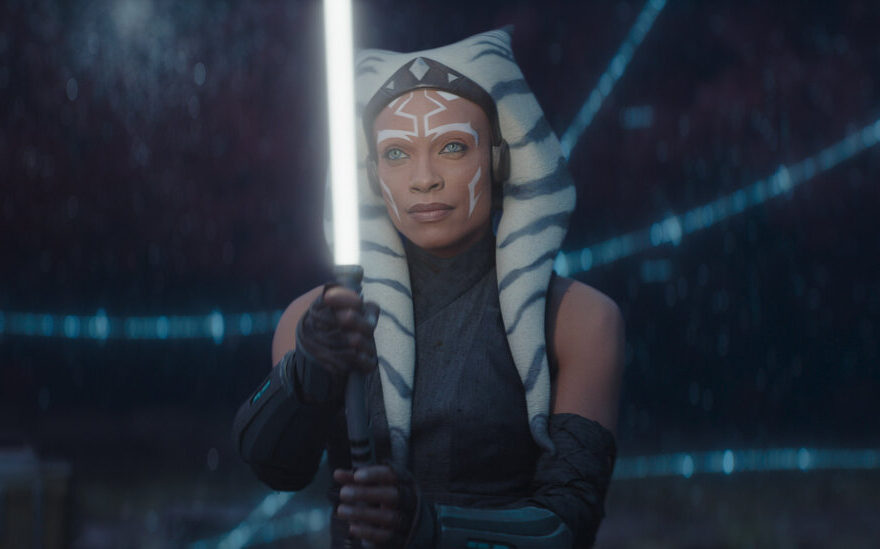The latest “Star Wars” series on Disney+ looks for new energy in the old formulas.


By Mike Hale
The first episode of “Ahsoka,” the new “Star Wars” mini-series on Disney+, is titled “Master and Apprentice,” because of course it is. Obi-Wan and Luke, Yoda and Luke, Obi-Wan and Anakin, Anakin and Ahsoka, the Mandalorian and the floating baby. “Star Wars” has one story and it’s sticking to it.
“Ahsoka,” two of whose eight episodes were available for review (they premiere on Tuesday night), is particularly true to the time-tested narrative of fractious mentorship and surrogate parenthood. It pits against each other two master-apprentice pairs, the lapsed Jedi Ahsoka Tano (Rosario Dawson) and her young Mandalorian protégé, Sabine Wren (Natasha Liu Bordizzo), on the side of good and the former Jedi Baylan Skoll (Ray Stevenson) and his grim sidekick, Shin Hati (Ivanna Sakhno), on the side of not good.
These four jump through space, clown around with droids (cute when they’re on the side of good, clanky and forbidding when they’re not), duke it out with lightsabers and summon the force with varying degrees of effectiveness while they search for Thrawn, an officer of the evil Empire. If found, he could be a danger to the nascent New Republic, which is in power after the events of the original “Star Wars” trilogy but not yet facing the existential threats it encounters in the most recent movies.
That will be important to “Star Wars” devotees and background noise to the rest of us — the overwhelming scale of the franchise, across every type of commercial medium, and the profusion of winding alleys down which its story lines run make it difficult for the casual fan to work up much interest in the world-building ramifications of any given installment.
“Andor,” an earlier Disney+ entry, countered this by doubling down on gritty, real-world political-historical texture, a move that generated great excitement among the cognoscenti but wasn’t, in the long run, all that rewarding. Dave Filoni, who created and wrote “Ahsoka” and directed several of its episodes, and Jon Favreau, who is one of its executive producers, have taken a more measured approach to the problem in their Disney+ collaborations (which include “The Mandalorian” and “The Book of Boba Fett”): They have made themselves purveyors of artisanal space opera.
This means that they serve the canonical narrative needs of the “Star Wars” franchise — you’ve seen all their story points before — while maintaining a good-humored, arm’s-length distance from its more sentimental and juvenile tendencies. They focus their energy on giving loving and capable attention to the genre trappings that can satisfy any viewer’s appetite for unencumbered entertainment.
In the opening episodes of “Ahsoka,” they meet this standard more than satisfactorily — better even than in “The Mandalorian,” which has served mainly as a baby Yoda delivery vehicle. The job of any “Star Wars” product is the competent execution of formula, and “Ahsoka” hits its marks.
It delivers on its alien landscapes, which toggle between barren desert vistas and crystalline cities, and on its monumental industrial environments. (The shipyards of Corellia come into play.) It delivers on its more-human-than-thou droids with the requisite prudent robot sidekick, engagingly voiced by David Tennant, the latest in a line of onscreen cautious companions stretching back to Bert Lahr in “The Wizard of Oz.”
And it delivers on its heroine, Ahsoka, a character who — in a perfect example of the all-purpose nature of the “Star Wars” franchise — was created as a toon and featured previously in the animated series “Star Wars: The Clone Wars” and “Star Wars: Rebels.” (In one of the show’s better in-jokes, a stately monument being dedicated to heroes of the resistance looks like a frame from “Rebels.”)
Bringing a cartoon alien to live-action life might not seem like the most invigorating challenge, but Dawson achieves something at least slightly alchemical in “Ahsoka.” Reining herself in, she cruises on what plays like her natural quality: a kind of reserved, amused disdain. It’s a perfect fit for a character who is very been there, done that and who doesn’t have a world of patience for the emotional excesses of her apprentice; Ahsoka may be humorless, but Dawson’s performance isn’t. And at the same time it evokes, in a clever way, the two-dimensional character of the cartoons.
It’s also helpful that, working with the fight coordinator Ming Qiu, the stunt coordinator J.J. Dashnaw and her stunt double, Michelle Lee, Dawson gives her battle scenes a visceral credibility.
With capable help from Stevenson (who died in May) and the always welcome Mary Elizabeth Winstead, who plays a New Republic general, Dawson lifts your attention above the “Star Wars” of it all. She even overcomes the scalp appendages she has inherited from the cartoon character, which look exactly like what they are: a dangling pair of rubber bags. The moment will inevitably come when you’re told that a mysterious edifice was built by “an ancient people from a distant galaxy.” But if you use your focus, you can block it out.
Mike Hale is a television critic. He also writes about online video, film and media. He came to The Times in 1995 and worked as an editor in Sports, Arts & Leisure and Weekend Arts before becoming a critic in 2009. More about Mike Hale
Site Index
Site Information Navigation
Source: Read Full Article
